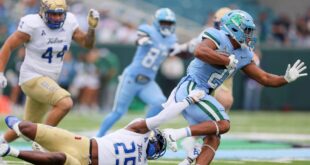“What football player of the Big Ten is of greatest value to his team?”
In October 1924, Chicago Daily Tribune sports writer Harvey Woodruff wrote that the newspaper had “authorized” him to answer that question.
The player chosen would receive “an award symbolic of the honor bestowed,” Woodruff wrote. “It will be a cup, trophy, emblem or something else of value which will always be a reminder of his successful days on the gridiron.”
According to Woodruff, Carl M. Green had suggested the idea for the award to him. Green, a Michigan alumnus and former director of advertising at Chalmers Motor Company, had originated the Chalmers Award in Major League Baseball.
Announced on March 25, 1910, the Chalmers Award promised a Chalmers Model 30, one of the most luxurious cars of the time, to the player with the major leagues’ highest batting average that season. The award, presented annually until 1914, marked the beginning not only of recognizing individual excellence — it led to the development of baseball’s Most Valuable Player award — but also of merging sports and commercial interests.
Originally intended for the “player of greatest value to his team” and not necessarily the “greatest player,” the Tribune’s football trophy was “to give the self-effacing chap who labors only for teamwork and team success an opportunity as nearly equal as possible to the ball carrier out in the limelight,” Woodruff wrote. “Success of the stars is made possible by the work seldom revealed to the spectators, of men who are blocking opponents and offering interference.”
The Tribune hoped the annual award, which preceded the Heisman Trophy by 11 years, would “become a much sought honor surpassing any now possible for these hard-working gridiron heroes whose efforts afford pleasure to so many thousand…
Source link : https://sports.yahoo.com/silver-football-born-selection-process-120000803.html
Author : Chicago Tribune
Publish date : 2024-08-11 12:00:00
Copyright for syndicated content belongs to the linked Source.
 NFL News NFL News, Reports and Updates
NFL News NFL News, Reports and Updates




